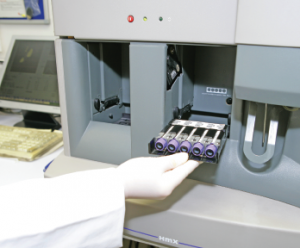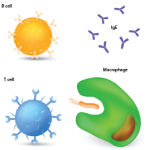
A technician inserts a rack of blood samples into the HmX flow cytometry machine.
BSIP/Science Source
SAN DIEGO—In his doctoral work, Sean Bendall, PhD, assistant professor of pathology and a researcher at Stanford University in Palo Alto, Calif., worked on protein identification and embryonic stem cell biology. That required examining the characteristics of cells—lots of cells. He was struck by how inefficient the process was.
“The issue was, every experiment I did required me to switch up 1 million, 2 million, 3 million cells and [pull] them out of the well to put them on the machine to get my list of proteins, and then I had to go back and figure out—one cell at a time because I was dealing with stem cells—what those proteins were doing,” he said in a talk at the 2017 ACR/ARHP Annual Meeting Nov. 3–8.
The traditional process of single-cell analysis is full of hurdles: The more information you try to get out of an assay, the more the signals can bleed into one another, and compensating for this interference sacrifices sensitivity and quantitative power. And you may have only one tube available for analysis. Plus, it’s time consuming.
Maybe there’s a better way, he thought.
Since then, his work has focused on ways of raising the multiplexing level of assays; that is, how to ask more questions of cells and obtain answers more quickly. Called “mass cytometry,” it’s an evolving approach that holds the promise of providing answers—in rheumatology and other fields—to questions researchers could barely even ask before, let alone answer.
The basic mass cytometry approach, developed several years ago but with new tweaks and applications all the time, involved changing from a fluorescence-based assay to one based on mass spectrometry, and using nonbiological elements as the cell characteristic reporters, such as europium and holmium. These elements are found in cell phone components and microchips, but not in the bloodstream, so there’s little interference from the biological background, Dr. Bendall said. “You’re only limited by how pure you can get the different reporters,” he said.
Once all the cells are stained, they’re diluted, then sprayed as single-cell droplets into a mass spectrometer—Dr. Bendall describes it as spraying a clear liquid into a box. Then the cells are converted into a cloud of ions, and then into an elemental measurement for each cell. The resulting readout shows the levels of the items researchers want to know about.

